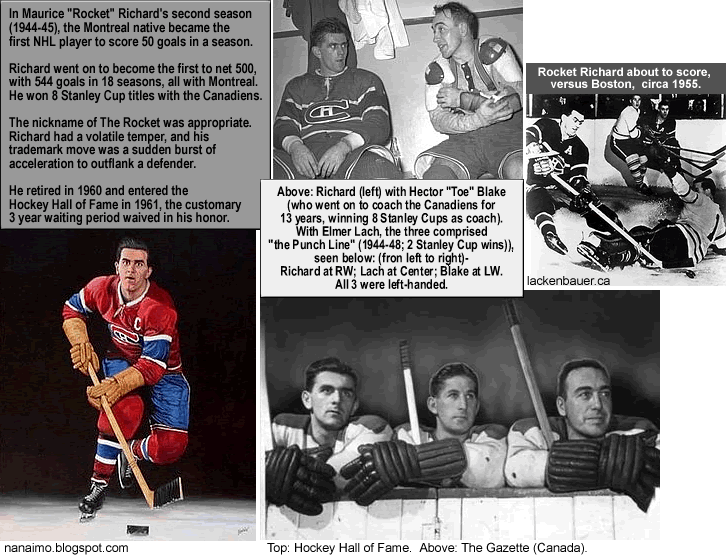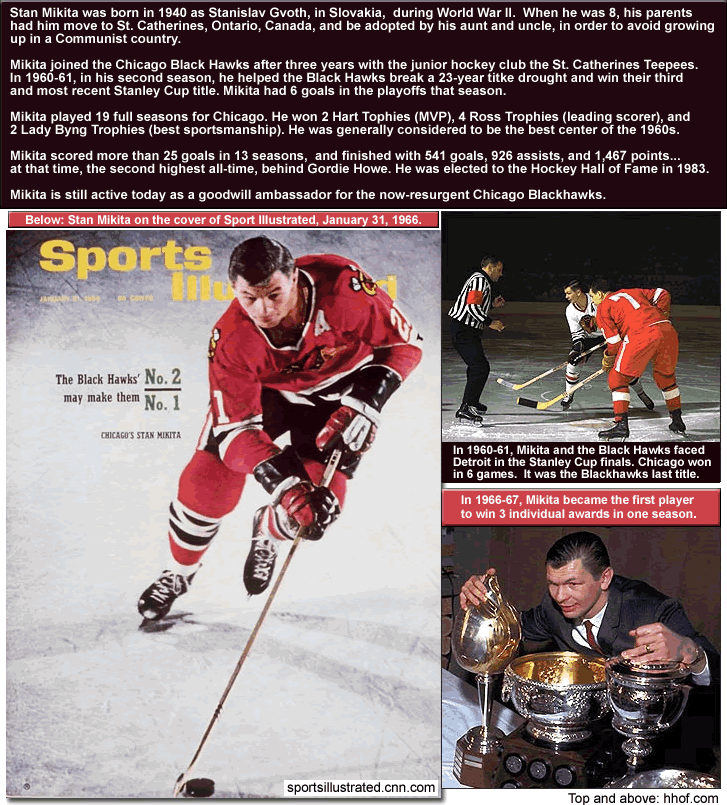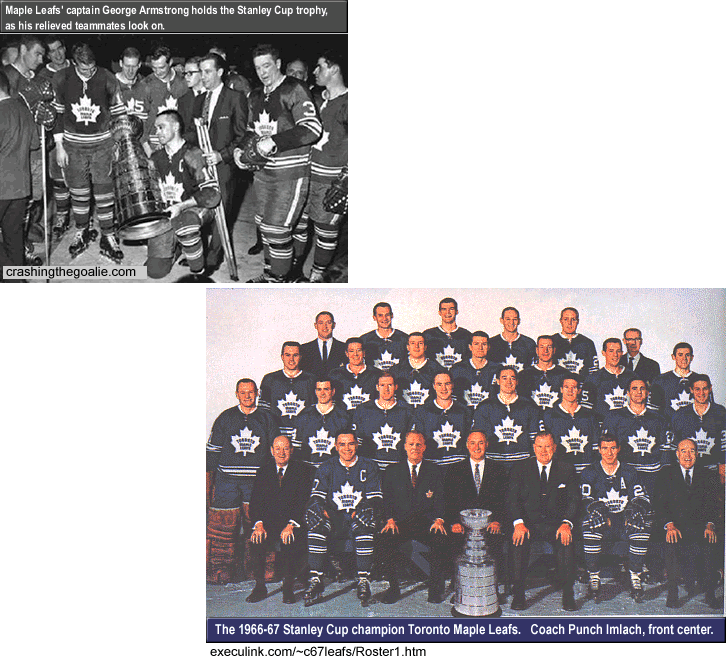…
…
On the map itself are the 1966-67 home (dark), and road (white) jerseys of the 6 NHL teams. [Dark jerseys were worn by home teams in NHL games up until 1969-70, then white jerseys (or yellow jerseys) for home teams was in effect from 1970-71 to 2002-03. In case you're wondering, the New York Rangers did not feature a white uniform until 1951-52.]
Near the top center are the 1967 Stanley Cup Playoffs jerseys of the eventual champions, the Toronto Maple Leafs. These jerseys were different from their 1966-67 regular season jerseys. The modernized leaf logo the Toronto hockey club first sported in the 1967 postseason mirrored the recently-instituted flag of Canada (the red maple leaf on white flanked by two red rectangles, established in 1965 {see this}, which replaced this flag of Canada, 1921-1964, {see this}). The modern Toronto Maple Leaf crest was revamped to a more streamlined look in 1970 {see this, from Chris Creamer’s Sports Logos Page}.
At the right of the map is a sidebar that shows NHL team jerseys from 3 other seasons in the 25-season era that this map depicts…1942-43, 1950-51, and 1958-59. Along with this are listed, from top to bottom, the Stanley Cup title winners from all the seasons of the Original Six era, plus the coach of each championship team. A list of the teams, and their total Stanley Cup titles during this era is to the bottom left of the sidebar.
-
Below, arguably the greatest player of the Original Six era, Maurice “Rocket” Richard…

The National Hockey League’s 25-season span from the 1942-43 season to the 1966-67 season featured just 6 teams, and is popularly known as the “Original Six” era. That name is very misleading, though, since only two of the six hockey clubs were actually original NHL teams…the Montreal Canadiens, and the Toronto Maple Leafs. The name Original Six dates to the NHL’s second expansion era, which began in 1967-68, when 6 new teams joined the “original ” six.
The most successful team of the “Original Six” era were the Montreal Canadiens, who won 10 of their 24 Stanley Cup titles during this 25-year period. Closely following them were the Toronto Maple Leafs, who won 9 Stanley Cup titles during this era (the Leafs have 13 Stanley Cup titles overall). The Detroit Red Wings were the only one of the four American teams in the league back then to challenge the domination of the two Canadian hockey clubs. The Red Wings won 5 Stanley Cup titles between 1942-43 and 1966-67, and have won 11 Stanley Cup titles overall.
The Bruins, the Black Hawks, and the Rangers languished for a couple reasons. First was that the NHL tolerated monopolistic practices. Red Wings’ owner James Norris held sway over the other three US-based teams in various forms. While owning the Red Wings, he also led a group which owned the Black Hawks for a time (1944-1952), putting virtually no investment into the Chicago hockey club. Chicago made the playoffs only once between 1949 and 1957. Norris was also the largest stockholder of the New York Rangers’ arena, Madison Square Garden, and maintained such support from the board that he effectively controlled the Rangers. And Norris had influence over the Bruins, as the result of mortgages extended to the Boston team to help keep it afloat during the Great Depression (Boston had only 4 winning seasons from 1947 to 1967). This led critics to joke that NHL stood for the Norris House League. Norris died in 1952, but the second-tier status of the Black Hawks, Bruins, and Rangers lived on. Throughout the entire 25-season Original Six era, the only time a team other than Montreal, Toronto, or Detroit won the championship was in 1960-61, when the Chicago Black Hawks won the Stanley Cup title.
Another way that Boston, Chicago, and New York were prevented from being competitive during this era was the 50-mile rule for exclusive rights to the signing of young players. Much of the talent coming out of the hockey hotbeds of Canada, around Toronto and southern Quebec, were thus out of the reach of all the four American teams except for Detroit, which of course borders Canada, thus putting the southwestern Ontario region centered around Windsor within the Red Wings’ 50 mile radius.
On the positve side, the level of play in the NHL was improving. Rule changes, such as the insertion of the center red line in 1943-44, led to a more exciting, passing-oriented (as opposed to stick handling-oriented) game. Air travel was used for teams for the first time in the late 1950s, and by 1960 the wearying train rides that players had to endure on road trips were a thing of the past. And there were legendary players like Montreal’s Maurice “Rocket” Richard {see illustration four paragraphs above}, Detroit’s Gordie Howe, and later in the era Chicago’s Bobby Hull, who captivated the public.
Televised hockey games in Canada began in November of 1952. Just as in other sports (such as Major League Baseball, and English football), some top brass feared televising games would hurt attendances. But the CBC’s Saturday night “Hockey Night in Canada” quickly became the highest-rated show in the country, and interest in the sport increased. Four years later, in 1956-57, in the United States, CBS was amazed at the popularity of their initial broadcasts of NHL games, and the network began a 21 game package the following season. Television brought new fans to the arenas. The league played to 93% capacity in the 1960s.
-
But during this era, labor conditions were poor, and the players were largely not benefitting from the popularity of the game. If players ran afoul of management, they were sent to the minors, where their salaries were cut, and the players themselves had to pay for their relocation fees. Injured players also had to pay their own medical bills, not getting compensation for two months. Players were not paid for off-season promotions, or for a share of profits from promotions such as trading cards (like Major League Baseball did for ballplayers). Players could not even supplement income as they had done in earlier years by playing off-season sports like lacrosse. But perhaps the most damning evidence of the perfidy of the NHL top brass is the pension plan cover-up. The pension plan, supposedly for the benefit of the players after retirement, was kept secret and hidden by the owners. The pension plan did not come to light until 1989, when it was revealed that there was a $25 million surplus that had never gone to former NHL players.
Another negative aspect of the 25-year period of 6 NHL teams is that the league was almost entirely composed of Canadian players. Very few American NHL players emerged during the 1950s and the 1960s. And in this quarter century there was just one example of a European NHL player, Ulf Sterner, who played briefly for the New York Rangers in 1965. This xenophobic attitude in the front offices towards non-Canadians did not end with expansion, though. It only ended when the World Hockey Association challenged the NHL in the 1970s, and WHA teams had success with European players. Also, the Canada Cup series, and its predecessor, the Summit series of 1972 and 1974, showed that Soviet (and by extension, European) players could compete with the best from the NHL.
The “Original” Six era ended when the NHL doubled in size from 6 to 12 teams, for the 1967-68 season. That expansion was only the beginning. Within a decade, exacerbated by the NHL’s response to the rival-league-WHA, there was the opposite problem: of over-expansion. Two more teams were added for 1970-71. Then, when the rival WHA began its formation circa 1971, four more NHL expansion teams were created within a three-year span (two more teams in 1972-73, and two more teams in 1974-75). Some of the teams (like the New York Islanders) were hastily formed to block a WHA team from forming there. So by 1974-75, there were 32 professional top flight hockey teams, with 18 teams in the NHL, and 14 teams in the WHA. A decade before, there had only been 6 major league hockey clubs !
-
1966-67 NHL season…
This was Canada’s Centennial year (so it was appropriate that the two Canadian NHL hockey clubs would meet in the finals).
Bobby Orr made his debut in the NHL, as a Boston Bruins defenseman. Orr would go on to revolutionize the defenseman position, and in fact the modern game of hockey itself, by giving the defenseman postion an attacking option. Injuries would cut Bobby Orr’s career short. He is the second-to-last NHL player to receive the honor of having the 3-year waiting period for entry into the Hockey Hall of Fame waived…he entered in 1979, one year after retiring (Wayne Gretzky is the last NHL player to go straight into the HOF after retirement).
In 1966-67, the Chicago Black Hawks won the [largely meaningless] regular season title easily, 17 points ahead of Montreal. It was the first time Chicago had won the regular season. The Black Hawks were a record-seting scoring juggernaut, with 5 players in the top 10 scoring leaders, including points leader Stan Mikita (Hall of Fame, 1983) and goal scoring leader Bobby Hull (Hall of Fame, 1983), who netted 50 times. For 1966-67, Stan Mikita tied Bobby Hull’s all-time scoring record (now held by Wayne Gretzky). Mikita also won three major honors that season…the Art Ross Trophy (top points scorer), the Hart Memorial Trophy (Most Valuable Player), and the Lady Byng Memorial Trophy (best sportsmanship). The latter award going to Stan Mikita was noteworthy for two reasons. First, only 5 NHL players have ever won the Hart (the MVP) AND the Lady Byng (ie, a player with very few penalty minutes who was a class act) in the same season, the two most recent instances being Wayne Gretzky in 1979-80, and Joe Sakic in 2000-01 (Mikita repeated this dual trophy haul the following season). Second, Stan Mikita spent the early part of his career among the leaders each season in penalty minutes, amassing totals above a hundred minutes a season several times. But by 1966-67, intense self-discipline had pared Mikita’s total penalty minutes that season to just 12 (two season before, he had 167 penalty minutes). He changed his tough guy act after his wife told him that his daughter, when watching her father play on television, had asked ”why does daddy spent so much time sitting down [in the penalty box].”
Stan Mikita also pioneered, circa 1962, the use of a curved blade on the hockey stick, to devastating, pin-point accurate results [note, others claim this invention, including Rangers' star Andy Bathgate.] But the self-effacing Mikita was overshadowed by the larger-than-life Bobby Hull, much like, in baseball back then, Roger Maris was overshadowed by New York Yankee teammate Mickey Mantle {see this (“Is Stan Mikita better than Bobby Hull ?”, from Greatest Hockey Legends.com, May, 2009)}.
In the first round of the playoffs, the star-laden Black Hawks were shocked by the third place Toronto Maple Leafs, losing in 6 games. Toronto won through the outstanding goaltending of Terry Sawchuck and Johnny Bower.
The Maple Leafs were coached by the mercurial taskmaster George “Punch” Imlach (Hall of Fame, 1984). He had been forced to take a leave of absence in February, for exhaustion, and the team actually improved their standing in his absence. The squad was captained by the longest-tenured captain in Leafs’ history, George “Chief” Armstrong (Hall of Fame, 1975), who eventually played 21 seasons for Toronto, 11 of them with the “C” on his jersey. Toronto featured a tandem of two aging but still effective goaltenders in Terry “Uke” Sawchuck (Hall of Fame, 1971), and Johnny “The China Wall” Bower (Hall of Fame, 1976). In that spring of 1967, Sawchuk was 37, and Bower was 42. There were several other long-in-the-tooth players on Toronto. Allen “Snowshoes” Stanley was 42. Leonard “Red” Kelley (Hall of Fame, 1969), a defenseman with good passing ability, was 40. Crucial to the Leafs defense was the reliable, 37-year old Tim Horton (Hall of Fame, 1977) (yes, that Tim Horton {Tim Hortons, here}).
The Maple Leafs offense was led by two younger veterans, the swift-skating and hard checking center Dave Keon (Hall of Fame, 1986), and left winger Frank “Big M” Mahovlich. Keon was a center who provided a defensive element through his checking ability. But Keon was a gentleman who almost never landed in the penalty box (most seasons he did not even amass a dozen minutes, and in 1,296 games he had 117 penalty minutes). Mahovlich, the son of Croatian immigrants, was a flighty genius on the ice who, when “on”, could totally dominate a game, but in actuality, it was an off-year (more like a two-year bad spell) for the acute depressive Mahovlich, and he only scored 19 goals that season (he did not get along at all with coach Imlach, and Mahovlich only resurrected his career when he was traded to the Red Wings the next season, going on to score 49 goals for Detroit in 1968-69).
1966-67 Stanley Cup finals, Montreal vs. Toronto…
Toronto would face Montreal in the finals, after the Habs swept New York in the first round. Coach of the Canadiens was Hector “Toe” Blake (Hall of Fame, 1966), who had played 13 seasons for Montreal, and ended up winning 3 Cups on the ice and 8 Cups as coach. Blake was an anglophone Quebec native who was bilingual. Blake’s ability to calm his former first-line partner “Rocket’ Richard had been a chief reason for his hiring in 1955.
Montreal were Cup holders (having beat the Red Wings in 6 games in the 1965-66 Stanley Cup finals), but had a poor regular season in 1966-67, finishing 17 points behind Chicago. Toe Blake felt that the offense had sputtered because so many of the Montreal players had been experimenting unsuccessfully with radically curved sticks which were all the rage.
The Canadiens were led by captain Jean Béliveau (Hall of Fame, 1972), and featured right winger Bobby Rousseau, who finished 6th on the scoring leaders list that season, and Henri “Pocket Rocket” Richard (Hall of Fame, 1979) (younger brother, by 15 years, of ”The Rocket”), who finished 10th in scoring that season. Among their goaltenders were a young “Rogie” Vachon, a 2-time Vezina Trophy winner (awarded to the goaltender[s] of the team with the least goals allowed); and the wily, eccentric, beer-bellied 36-year old Lorne “Gump” Worsely (Hall of Fame, 1980), who went on to be one of the last NHL goalies to play without a mask.
[The Maple Leafs had lost to Montreal in the first round of the playoffs in the two previous seasons, as Montreal went on in both 1964-65 and 1965-66 to win Stanley Cup titles.]
In the first game, at the Montreal Forum, les Canadiens cruised to a 6-2 victory that featured a hat-trick by Henri Richard. Imlach put Bower in goal for game 2, and Bower produced a 3-0 shutout.
In game 3 at Maple Leaf Gardens, after 60 minutes of regulation the score was knotted 2-2, with Vachon stopping 62 shots and Bower repelling 54. The game went to a second overtime before Bob Pulford (Hall of Fame, 1991) won it for Toronto. But Bower was injured warming up for game 4, so it was back to Sawchuck for the Leafs. Again, he let in half a dozen, and again Montreal won 6-2.
But Sawchuk came through when the series returned to Montreal for game 5, helping Toronto to a 4-1 victory. And in game 6, in Toronto, Sawchuck stopped 41 shots, and Leafs right-winger Jim Pappin scored his seventh playoff goal en route to a Cup-clinching 3-1 victory.
The Stanley Cup was now now in the hands of the Toronto Maple Leafs. Dave Keon was awarded the Conn Smythe Trophy, for player judged most valuable to his team during the playoffs.
The Toronto Maple Leafs of 1966-67 are the oldest team to ever win a Stanley Cup title, with an average age of 31.
In the 100th anniversary of the birth of the Canadian nation, the hockey club which shared the national symbol of the maple leaf was champion. The Toronto Maple Leafs have never won another Stanley Cup title.
Here is a Youtube video posted in 2008, which is about 9 minutes long…it shows the final 55 seconds of the 6th game of the 1966-67 Stanley Cup finals, then the traditional handshaking between teams after, and then NHL commisioner Clarence Campbell presenting the Stanley Cup to Maple Leafs’ captain George Armstrong. It’s not very action-packed, but it does give you a good idea of what hockey on television looked like circa 1967. Plus, at 2:35 in the video, you can see Terry Sawchuk’s rather frightening, primitive goalie mask (also shown in the photo section above) {click here}.
…
From TheLeafsNation.com, ‘THE FATE OF THE ORIGINAL SIX ARENAS‘.
…
Thanks to Jersey Database.com, for jerseys {click here}. All the jerseys on the map and the sidebar to the right of the map are from this site. Thanks to LogoServer {click here}. Thanks to the contributors to the pages at en.wikipedia.org {click here (set at NHL page}. Thanks to http://www.legendsofhockey.net . Thanks to the Hockey Hall of Fame site {click here}.
Thanks to “The Official National Hockey League 75th Anniversary Commemorative Book”, edited by Dan Diamond, published by McLelland and Stewart, Inc., Toronto, 1991; 1994 edition {at Amazon.com, here}.




